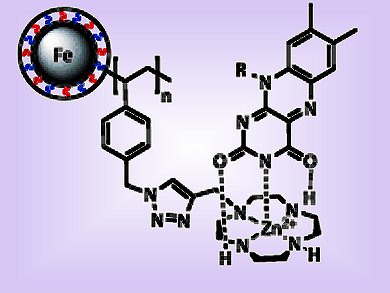Because riboflavin, also known as vitamin B2, is an important component of redox cofactors and essential for a variety of cellular processes, its extraction and quantification is of analytical interest.
Burkhard König, Oliver Reiser, and colleagues, University of Regensburg, Germany, functionalized azide-substituted, polymer-coated magnetic Fe/C nanoparticles with a propargylated cyclen building block using “click” chemistry. After complexation of zinc(II), riboflavin is readily immobilized via coordination to the zinc(II)–cyclen complex at pH 7.4 (pictured). Release is achieved at lower pH 3.6 allowing for its quantification in solution. This reversible process could be repeated for at least six cycles. Quantification of riboflavin was also achieved from a vitamin tablet representing a more complex matrix.
Image: © Wiley-VCH
- Magnetic Nanobeads as Support for Zinc(II)–Cyclen Complexes: Selective and Reversible Extraction of Riboflavin,
Quirin M. Kainz, Andreas Späth, Stefan Weiss, Thomas D. Michl, Alexander Schätz, Wendelin J. Stark, Burkhard König, Oliver Reiser,
ChemistryOpen 2012, 1(3), 125–129.
DOI: 10.1002/open.201200008
ChemistryOpen – the first society-owned, open-access, chemistry journal – is a journal of ChemPubSoc Europe published by Wiley-VCH.



